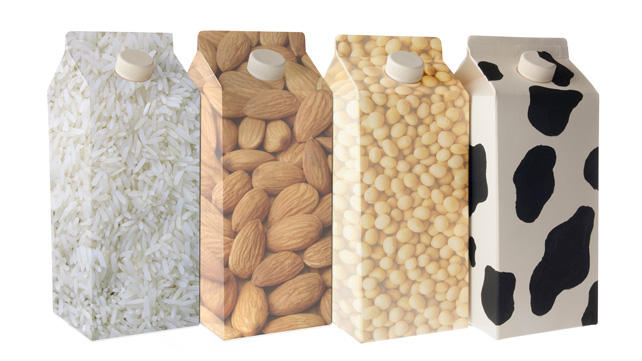
Plant-based milk is delicious, cruelty-free, and a great way to oppose the dairy industry. With these easy steps, you can make your own milks from the comfort of your kitchen.
Almond Milk
Almond milk is one of the most popular plant-based milks on the market, but store-bought almond milk is expensive. Good news: it’s super easy to make at home. All you need are almonds, water, and a sweetener of your choice to flavor your milk. You will also need a large jar, a blender or food processor, a cheesecloth, and measuring cups.
The first step is to soak your almonds in water (the longer you soak the almonds, the creamier and smoother your milk will be). We recommend soaking your almonds 24 to 48 hours. After soaking the almonds, drain the water into a strainer and separate the almonds (they should have a squishy texture and be plump from the water).
Next, place your almonds into a blender or food processor with two fresh cups of water. Don’t use the leftover water from the almond soak. Blend the almonds with the water for a couple of minutes until the texture of the almonds is fine and the water is cloudy and opaque.
Strain the almond meal from the liquid using a fine strainer lined with a cheesecloth, and press the cheese cloth together to drain the almond milk from the almond meal. One cup of raw almonds should create about two cups of fresh almond milk. Finally, add your sweetener of choice. No measurements are needed — follow your heart.
Fresh almond milk keeps for a few days in the refrigerator, so don’t make too much at once. Pro tip: start soaking your next batch of almonds that same day so you don’t have to wait for the next batch.
Soy Milk
Soy milk is another great and popular alternative to cow’s milk and, like our other favorite plant-based milks, it’s easy to make at home. All you need are yellow soybeans, water, a blender, a strainer, cheesecloth, and a stove.
To start, soak the soybeans in water overnight to soften them. Like almonds, it is important to soak your soybeans in order to create smooth and creamy milk. Pro tip: use yellow soybeans as they have the best flavor to make soy milk.
Drain the soybeans and make sure to remove the outer skins. (I’ll be honest, this is the most tedious and time-consuming part, but it’s worth it.) Then, blend the soybeans in three cups of fresh water until smooth. Don’t reuse the water from the soybean soak. You can also add sea salt or sweetener at this step to add flavor to your soy milk.
Strain the mixture using a cheesecloth into a pot on the stove and add another cup of fresh water. Boil the mixture on the stove for about 20 minutes, stirring constantly, and remove the foam off the top of the milk periodically using a spoon or ladle. It is important to boil this mixture because soybeans are legumes and cannot be eaten raw.
After boiling, remove the milk from the heat and let cool. Serve any way you like and enjoy.
Oat Milk
Oat milk is even easier to make than almond or soy milk because the oats don’t need to be soaked before blending. All you need are one cup of rolled oats, four cups of water, a blender or food processor, a t-shirt or towel for straining, and a jar.
Start by blending your oats and water for about a minute. After blending, strain the mixture with a t-shirt or thin towel into a jar. To add extra flavor, you can blend the oats with sea salt, a date, berries, or cacao powder.
Looking for vegan inspiration? Check out our delicious recipes and join us on Facebook.

Comments 2
What’s the quantity of soybeans to use?
Thank you, making your own tastes best. Almond milk is delicious. However, we all need more omega 3 fats because we ingest too many omega 6 fats (found in higher amounts in peanuts, almonds, and most other nuts). Omega 3 fats (which lower inflammation) are found in higher amounts flax seeds, hemp seeds, chia seeds, and walnuts–so I would suggest making milks with walnuts and hemp seeds.